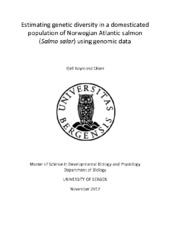| dc.contributor.author | Olsen, Kjell Roymond | |
| dc.date.accessioned | 2018-01-11T12:25:00Z | |
| dc.date.available | 2018-01-11T12:25:00Z | |
| dc.date.issued | 2017-12-15 | |
| dc.date.submitted | 2017-12-14T23:00:02Z | |
| dc.identifier.uri | https://hdl.handle.net/1956/17188 | |
| dc.description.abstract | New developments of high throughput sequencing technologies have allowed for breeders to assess values related to loss of genetic diversity in domesticated animals on a genomic level for better accuracy than the pedigree used so far. This accuracy is important because loss of diversity has close ties to how much selection strength can be applied, and the sustainability of the population. In this thesis the genetic diversity, rate of inbreeding (ΔF), effective population size (N_e) and population structure in the nucleus of a domesticated population of Atlantic salmon (Salmo salar) was analysed. The results of this analysis were used to assess whether or not the same selection strength used today can be upheld for retention of genetic diversity in future generations. A total of 3596 animals were included, spread over 486 families and 5 year classes (YC) sequenced on two single nucleotide polymorphism (SNP) chips. To quality control the data, pruning for genotyping call rate (<90%), missing SNPs per individual (>5%) and Hardy-Weinberg equilibrium (p<1E-06) were performed, reducing the initial 30 318 SNPs to between 25k and 30k for the various data sets. Genetic diversity was measured as observed homozygosity (F_HOM) and ranged from 62.3% (SE=±0.02%) to 64.2% (SE=±0.01%) in the YCs. ΔF per generation was measured as regression of a linearized F_HOM on YC to be 0.9% (p<0.05), and corresponded to an N_e of 58.4. The population structure was assessed as F_ST using the method developed by Weir and Cockerham (1984) both within- and among YC and ranged from 14.9% to 24.2% and 0.2% to 4.8%, respectively. Multidimensional scaling was furthermore used to assess the data basis and population structure. These results suggest that the population in question has retained genetic diversity, a sufficiently low ΔF and high N_e so that selection strength can be upheld at the same levels as today. | en_US |
| dc.language.iso | eng | eng |
| dc.publisher | The University of Bergen | en_US |
| dc.subject | Breeding | eng |
| dc.subject | Genetic diversity | eng |
| dc.subject | Atlantic salmon | eng |
| dc.subject | inbreeding | eng |
| dc.subject | Effective population size | eng |
| dc.subject | Salmo Salar | eng |
| dc.subject | Lakseoppdrett | nob |
| dc.subject | Oppdrettslaks | nob |
| dc.subject | Oppdrett | nob |
| dc.subject | Genetisk variasjon | nob |
| dc.title | Estimating genetic diversity in a domesticated population of Norwegian Atlantic salmon (Salmo salar) using genomic data | en_US |
| dc.type | Master thesis | |
| dc.date.updated | 2017-12-14T23:00:02Z | |
| dc.rights.holder | Copyright the Author. All rights reserved | en_US |
| dc.description.degree | Masteroppgave i biologi | en_US |
| dc.description.localcode | BIO399 | |
| dc.subject.realfagstermer | https://data.ub.uio.no/realfagstermer/c012711 | |
| dc.subject.realfagstermer | https://data.ub.uio.no/realfagstermer/c009548 | |
| dc.subject.realfagstermer | https://data.ub.uio.no/realfagstermer/c012515 | |
| dc.subject.realfagstermer | https://data.ub.uio.no/realfagstermer/c012751 | |
| dc.subject.nus | 751999 | eng |
| fs.subjectcode | BIO399 | |
| fs.unitcode | 12-60-00 | |
